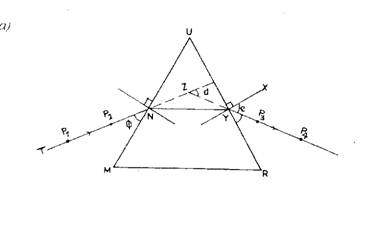Question 2A

You are provided with a triangular glass prism, four optical pins and
other necessary materials.
(i) Place the triangular glass prism on a drawing paper and draw
its outline UMR Remove the prism .
(ii) Measure and record the value of the angle at U.
(iii) Draw a normal to the line UM at N. Also, draw another line
TN to the normal such that <P = 60°. Fix two pins at P 1 and P2.
(iv) Replace the prism and fix two other pins at P 3 and P4 such that
the pins appear to be in a straight line with the images of the
pins at P1 and P 2 when viewed from the side UR. Remove the
prism.
(v) Join points P3 and P4 producing the line to meet TN produced
at Z. Draw the normal XY .
(vi) Measure and record the angle of emergence, e and that of
deviation d.
(vii) Repeat the experiment with <P = 55°, 50°,40° and 35°.
(viii) In each case, measure and record the corresponding values of
e and d.
(ix) Tabulate your readings.
(x) Plot a graph with d on the vertical axis and e on the horizontal
axis starting both axes from the origin (0,0). Join your points
with a smooth curve.
(xi) From your graph, obtain the minimum deviation dm and the
corresponding angle of emergence. Hence, calculate the
refractive index n of the prism using the formula:

(xii) State two precautions taken to obtain accurate results.
Attach your traces to your answer booklet.
(b) (i) State the conditions necessary for total internal
reflection of light to occur.
(ii)The critical angle for a transparent substance is 39°.
Calculate the refractive index of the substance.
Observation
Part (a). This was a popular question among the candidates. Majority of the candidates performed poorly in carrying out the tracing and measuring the angles e and d. Some candidates did not draw xy perpendicular to side UR of the triangle hence they could not score for e. Some few candidates handled the question with high degree of accuracy. Candidates had difficult time in drawing a smooth curve to join the points of the graph. Some had a straight line instead and this affected their deductions.
Precautions were well stated.
Part (b) (i) This part was well handled by most responding candidates while part (ii) was poorly attempted.
Candidates were expected to:
Draw 5 complete traces (showing at least incident ray, emergent ray, and
angle of deviation)
Record value of U in degrees as 60o![]() o
o
Measure and record five values of ![]() correctly and in trend
correctly and in trend
Trend: as ![]() decreases ,e decreases
decreases ,e decreases
Measure and record five values of d and in trend.
Trend: as ![]() decreases, d decreases and later increases.
decreases, d decreases and later increases.
Record composite table ![]() e and d
e and d
Distinguish both axes
Plot graph using reasonable scales
Draw a smooth curve
Evaluate the slope
Deduce dm and corresponding em.
State any two of the following precautions
- Evidence of sharp pencil/neat traces
- Evidence of enough pin spacing ( about 4 cm apart )
- Ensured pins were vertical / erect
- Avoided parallax error when reading protractor
- Repeated readings shown on table
The expected answers for part (b) are:
(i) - Light must be travelling from a dense medium to a less dense medium.
- Angle of incidence in the dense medium must be greater than the critical
angle .
(ii) n = refractive index
n = ![]()
= ![]()
= ![]()
= 1.59
